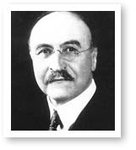Baekeland, Leo Hendrik

One of the earliest synthetics that transformed the material basis of modern life was Bakelite, a polymeric plastic made from phenol and formaldehyde. Leo Hendrik Baekeland (1863–1944) invented Bakelite in 1907, and his inventive and entrepreneurial genius also propelled him into several other new chemical technological ventures at the turn of the 20th century.
After completing his doctorate at the University of Ghent in his native Belgium, Baekeland taught for several years. In 1889, when he was 26, he traveled to New York on a fellowship (that had also allowed him to visit universities in England, Scotland, and Germany) to continue his study of chemistry; Professor Charles F. Chandler of Columbia University then persuaded Baekeland to stay in the United States and recommended him for a position at a New York photographic supply house. This experience led him a few years later, when he was working as an independent consultant, to invent Velox, an improved photographic paper that could be developed in gaslight rather than sunlight. In 1898 the Eastman Kodak Company purchased Baekeland's invention for a reputed $750,000, a sum that allowed him to spend the rest of his life in experimentation.
Baekeland next entered the field of electrochemistry. He visited Berlin briefly to update his knowledge of this new area of study, and he equipped his private laboratory on the grounds of his home in Yonkers, New York, with a few electrochemical appliances. At the request of Elon Hooker, Baekeland cooperated with Clinton P. Townsend, the inventor of a new electrolytic cell for producing caustic soda and chlorine from salt, in setting up a pilot plant at the Brooklyn Edison Station. The success of their experiment led Elon Hooker to form Hooker Electrochemical Company in Niagara Falls—now part of the Oxychem subsidiary of Occidental Petroleum.
When friends asked Baekeland how he entered the field of synthetic resins, he answered that he had chosen it deliberately, looking for a way to make money. His first objective was to find a replacement for shellac, which at that time was made from the shells of oriental lac beetles. Chemists had begun to recognize that many of the natural resins and fibers useful for coatings, adhesives, woven fabrics, and the like were polymers (large molecules made up of repeating structural units), and they had begun to search for combinations of reagents that would react to form synthetic polymers. Baekeland began to investigate the reactions of phenol and formaldehyde, and first produced a soluble phenol-formaldehyde shellac called "Novolak," which never became a market success. Then he turned to developing a binder for asbestos, which at that time was molded with hard natural rubber. By carefully controlling the pressure and temperature applied to an intermediate made from the two reagents, he could produce a polymer that, when mixed with fillers, produced a hard moldable plastic. Bakelite, though relatively expensive, was soon found to have many uses, especially in the rapidly growing automobile and radio industries. Baekeland retired in 1939 to sail his yacht, the Ion, among other activities, and sold his successful plastics company to the Union Carbide and Carbon Corporation.
Further Reading